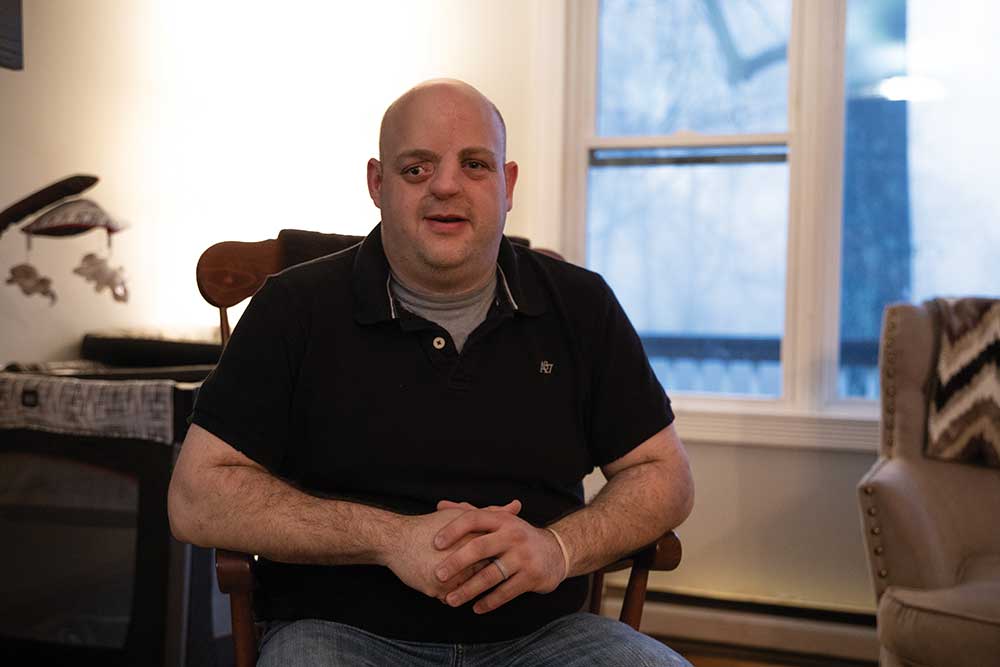There are known carcinogens (C8) in your frying pan, dental floss, and favorite outdoor jacket. Documentary lead Bucky Bailey fights for his family’s health—and yours.
The story of C8 and the DuPont plant in Parkersburg, W. Va. is a complicated one. It’s a story of lies and deceit, livelihoods and lives lost. It’s the story of a chemical that has remained in the environment for decades and the people dealing with its very real effects today.
One of those people, William “Bucky” Bailey, moved away from the Parkersburg community at a young age. He now lives on the border of Virginia and West Virginia, where the two state governments argue over who is responsible for maintaining the road.
“I love living up here in Northern Virginia, just far enough out of the city where I can walk outside of my house and not hear anything,” he said.
Bailey is one of the lead figures in the documentary The Devil We Know, which tells the story of the contamination of the Parkersburg community and the subsequent DuPont cover up.
In 1951, DuPont started using C8, a perfluorooctanoic acid (PFOA), at their plant in Parkersburg for the production of Teflon. This water, grease, and stain repellent coating has been used in a variety of products, including cookware, apparel, and upholstery.
For more than 50 years, the company released the byproduct of Teflon into the air and water surrounding the plant, knowing the health impacts the chemical could have on the environment and people living in the area. A study done by 3M, the original manufacturers of C8, found the chemical caused a variety of health problems in rats, including some birth defects.
Sue Bailey worked at the Parkersburg plant with the C8 waste while she was pregnant with her third child. When Bucky Bailey was born in January 1981, he had similar birth defects to his nose and eye that were found in the rats.
Soon after Sue Bailey returned to work at the plant, DuPont transferred all female employees out of areas where they might come in contact with C8.
A few years later, the Bailey family moved away from the Parkersburg area. But Sue Bailey kept thinking about the link between working at the DuPont plant and her son.
“My mom knew what was up,” Bailey said. “She knew what the links were. My grandpa had made notes of my blood level. She knew she had evidence. We went back to talk to some lawyers and pretty much had doors shut in our face. So, we kind of just let it go. At the point, I am seven, eight, nine years old and I’ve got half a nose. I’d probably already had 15 to 20 surgeries on my face.”
For most of his childhood, Bailey didn’t think much about confronting DuPont.
“From ages 10 to 22, my concern was getting past these surgeries,” he said. “I had surgeries that were in excess of eight hours where 120 stitches were put in my face at one time. Rib cartilage was taken out. Balloons in my forehead to stretch my skin. So, at that point, I wasn’t really worried about DuPont. I was worried about questions like: Am I going to be able to go to school in the fall? Am I going to be able to be normal? Am I going to be able to have a girlfriend?”
Hitting the National News
In 2001, attorney Rob Bilott brought a class-action suit against DuPont on behalf of residents in the area. During the discovery phase of the trial, thousands of documents came out about what DuPont and 3M knew about the chemical.
The Environmental Working Group, a nonprofit dedicated to researching and educating the public on environmental issues, published many of those documents online for the public to see.
“One of the reasons that we know a lot about the health effects of these chemicals are because of that original trial in Parkersburg, West Virginia,” said David Andrews, a senior scientist with the Environmental Working Group. “One of the unique agreements that came out of that trial was that DuPont paid for a scientific study, as well as monitoring of the surrounding community. Just over 70,000 people were studied. They measured the blood levels of PFOA and then they looked at health outcomes. These studies led to probable link reports where the higher concentrations were linked to a number of specific health outcomes.”
From 2005 to 2013, the C8 Science Panel studied people in six water districts in the Mid-Ohio Valley for links between exposure to the PFOA chemical and a number of diseases. The panel determined that high cholesterol, ulcerative colitis, thyroid disease, testicular cancer, kidney cancer, and pregnancy-induced hypertension could all be linked to exposure to C8.
C8 is just one chemical under the family of chemicals known as per- or polyfluoroalkyl substances (PFAS). There are an estimated 4,800 chemicals in this family, although the Environmental Protection agency says that only 600 of those have been commercially active in the last ten years.
Studies done by the Centers for Disease Control under the Department of Health and Human Services found these “forever chemicals” in the blood of nearly every American.
“Carbon-fluorine bonds are incredibly sturdy, and they don’t break down under any normal environmental process,” Andrews said. “Once these chemicals are released into the environment, they are essentially there forever. When released into the ground, released into the water, it will be there for years, centuries, millennia. They will spread out over time, but because of how potent they are at incredibly low concentrations, that may actually make the problem much worse.”
Bailey was newly married when he learned about the investigation and suit. He remembered his mother talking about the link between C8 and his deformities, something he hadn’t focused on in his childhood.
While Bailey participated in the medical study, the panel determined there was not enough of a significant sample size to link his deformities with the chemical.
“Since the deformities were not found as part of the conclusion of that study, I waived my right to pursue any type of litigation against DuPont,” he said. “I’ve never expected to get a dime from DuPont. I don’t expect to get a dime from DuPont. That’s not what drives me. People have lost so much. I’m sitting here today. I’m healthy. I’ve got a healthy wife, a healthy kid. That’s more to me than anything.”
However, Bailey continues to speak out about the issue.
At several points after the class-action suit, he thought the story of Dupont and C8 would break big time on the national scene. He sat down for countless interviews with 20/20, The Intercept, The Huffington Post, and BBC News, as well as several mini documentaries.
But each time a new article was released, or documentary premiered, nothing seemed to happen at the institutional level.
“I hate to be the pessimist, but I don’t think anything will ever quantify what needs to be done,” Bailey said. “There’s no story that can be told, there’s nothing, no matter how big this is, no matter the hundreds of millions of dollars, there is still nothing compared to the profit that they have made and are still making. I think that the only thing that’s going to have an effect is shutting down this product and shutting down this company.”
Although DuPont and other companies voluntarily discontinued their use of PFOA, replacements such as GenX have already been found in places like the Cape Fear River in North Carolina.
“All of them have very little health and safety data,” Andrews said. “The information we do have for some of those replacements is incredibly concerning. GenX is one of these replacement chemicals. Nearly a dozen studies indicated very similar health impacts as PFOA. I think some of those assumptions the EPA made over the last decade when allowing all these new chemicals on the market are really coming into question now in terms of the adequacy of that review. Our concern is that the bar was way too low.”
So far, the EPA has not set a national standard for the presence of PFAS chemicals in drinking water.
“With where we’re at today with the EPA, I don’t have any hope,” Bailey said. “There is nothing being done. There are no federal standards against the chemicals unless it’s poison gas. If it can be consumed and not kill you, we’re going to allow it. It’s not going to change until we hold people to a higher standard. Unfortunately, the issue with that is one person doesn’t think that they can do it by themselves and it doesn’t matter. That’s where our mentality has to change. My single action, my individual actions will make a difference.”
Moving Forward
In 2018, The Devil We Know premiered at the Sundance Film Festival. Although Bailey had seen pieces of the rough draft, it wasn’t until opening night that he saw the film in its entirety.
Some of the footage he had never seen before that night, including testimonies from several DuPont employees.
“This was worth it, every long night of filming,” he said. “I look back over my life and it was even worth it going through the struggles that I did just to be able to share my story. I’m a Christian believer and this kind of affirmed my faith that we all go through things for a reason. We all have to be a testimony. We all have to understand that we don’t always have it the worst off. There’s always someone else. But we still need to speak up, be the light, and do what we can.”
Unlike some of the smaller documentaries Bailey participated in, production for The Devil We Know lasted around three years. In that time, the Baileys welcomed a son.
“I was having conversations with my mother that were real,” Bailey said. “Nothing was ever staged. Some of the camera shots were staged but that was about it. That was real conversation, real concerns that I had with my son being born, about my father not being here. Just being able to talk to my dad to know what he felt during this point. Or thinking about what my mom had to go through. It was raw.”
Since then, the film has premiered all over the world and is now available for streaming on Netflix and Amazon.
In February, the EPA released an action plan on fluorinated chemicals.
“The action plan seemed to be almost exactly the same as what the EPA said they were doing over a decade ago,” Andrews said. “Most of it was a plan to further study these chemicals, look into setting a drinking water limit. They laid out a lot of different options but really took no specific action on these chemicals. That’s the part that’s sorely needed here. Ultimately, we think that the companies and manufacturers that made and released these chemicals into the environment should be responsible for paying for the cleanup and clean drinking water.”
Without a concrete plan moving forward at the institutional level, individuals like Bailey are continuing to speak up about the harmful effects of these chemicals in our water.
“The revenge doesn’t drive me,” Bailey said. “I don’t want to sound like I don’t want justice for people, because I do. There has to be some justice for these people. I’m fine with not taking another step towards DuPont for myself. I’m not okay with hearing about chemical dumping in my country. I’m not okay with hearing this chemical is in the water in the Cape Fear River. That’s not okay to me and that drives me more each day to spread the word. I’ve got a beautiful son and a daughter on the way. They’re going to have to live in this world and drink water and take showers. That’s what drives me to never give up. To not let it fall by the wayside as it tends to do so easily.”
As his children grow up, Bailey hopes to pass on the same resiliency that his parents taught him.
“There were times that I thought I was at my breaking point, but God had other plans,” he said. “There were times when I thought that my life wasn’t worth living, to be honest. I had so many battles, but my parents pushed and pulled me. They gave me the support that I need. I hope that’s what I’ve done for them. For them to be able to have a voice no matter what and to speak up for others.”







